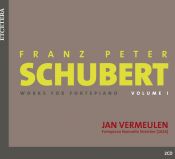Franz Schubert - Works for fortepiano Volume I
| Type: | album |
|---|---|
| Formaat: | CD |
| Componist(en): | Franz Schubert |
| Uitvoerder(s): | Jan Vermeulen |
| Label(s): | Et'cetera |
| Label code: | KTC 1330 |
| Distributeur: | Codaex |
| Releasedatum: | 11.2006 |
| Aanwezig in Muziekcentrum | ja |
| Plaatsingsnummer: | 001534 |
| Genre(s): | romantiek |
CD1:
1-4. Sonate voor piano, nr. 19, D. 958 in c kl
5-6. Zwei Scherzi , voor piano, D. 593
7-8. Sonate voor piano, nr. 14, D. 840 in C gr "unvollendet"
CD2:
1-4. Sonate voor piano, nr. 20, D. 959 in A gr
5-7. Sonate voor piano, D. 537, op. posth. 164 in a kl
een 7 in Crescendo
Certes, l'interprète sait faire sonner l'instrument. Certes, il ya a aussi de beaux moments. mais je ne suis pas envolé vers ces mondes extraordinaires que cette musique est, plus que bien d'autres, capable de faire entrevoir. (Benoît Jacquemin, Crescendo nr. 86 febrauri-maart 2007, p. 58)
Jan Vermeulen pakt opnieuw Schubert aan. ()... zijn betrokkenheid bij de restauratie van een ander instrument deed hem belsuiten dat er een enorme affiniteit was tussen dat instrument en de muziek van Schubert. Het is een Nannette Streicher-pianoforte, in 1826 in Wenen gebouwd. De klank van dat instrument is delicater en bescheidener dan wat de robuste Tröndlin voortbrengt. Ideaal dus voor de bijzondere instimiteit van de klaviermuziek van Schubert.
(Mark Janssens, Muziek en Woord nr. 391, april 2007, p. 25-26)
7 in Luister
In de minder grootschalige werken komen Jan Vermeulen en zijn instrument beter tot hun recht. Al met al een boeiende start van een Schubert-serie. (Hans Quant, Luister nr. 641, april 2007 p. 40)
Dutch pianist Jan Vermeulen (...) makes a very strong case for hearing some major Schubert pieces as Schubert heard them. (...) The album would rank as an exceptional example of the analysis of an instrument's potentialities by a performer (...) and Vermeulen's performances are powerfully expressive. (...) What makes Vermeulen's performance remarkable is that he zeroes in on the passages where Schubert broke free of Beethovenian models and uses the unique qualities of the piano to highlight them. Nowhere is this more true than in the Andantino second movement of the Piano Sonata in A major, D. 959. (...) Vermeulen pushes the fortepiano to its limits in an absolutely riveting performance. In general Vermeulen tends to accent the impromptu-like passages in Schubert, which in conventional performances tend to come off as relaxed and lyrical, with a good deal of expressive tension and tempo flexibility. He does best in movements with a wide variety of textures, and another highlight is the massive opening movement of the unfinished "Reliquie" Piano Sonata in C major, D. 840, whose size seems almost amplified by the range of sounds that come out of Vermeulen's fortepiano. Constantly surprising, this album stands up to doubts and makes you hear Schubert in some entirely new ways....
(James Manheim, www.allmovie.com/cg/amg/dll?)
"Vermeulen gave the instrument [Nannette Streicher, 1826] its modern premiere in 2002 playing Schubert sonatas and clearly has a special sense of identity with the composer, playing with a poetic flexibility and improvisatory freedom reminiscent of András Schiff’s complete Decca cycle. (...) in Vermeulen’s persuasive hands one quickly adjusts to the ‘shock of the new’." (s.n., International Piano nr. 51, mei/juni 2007, p. 83)
Für alle Hammerflügel-Enthusiasten war der Fund eine kleine Sensation: Auf dem Dachboden eines belgischen Landsitzes wurde im Mai 1998 ein noch weitgehend intakter Wiener Hammerflügel von 1826 aus der Werkstatt der berühmten Klavierbauerin Nannette Streicher entdeckt. Ein Instrument mithin, wie es einst Schubert in den Wiener Salons zur Verfügung hatte. Näher dran geht vermutlich nicht, und tatsächlich unterscheidet sich der Klang des Streicherinstruments stark von dem Fritz-Fortepiano, das beispielsweise Andreas Staier für seine maßgebliche Einspielung der c-moll- und A-Dur-Sonaten nutzte: Im Diskant relativ obertonarm, im Bass leicht, mit relativ kurzer Tongebung beschwört das Streicherpiano eine intime, etwas steife Salonatmosphäre – richtig laut kann man auf diesem Instrument vermutlich gar nicht werden. Der trockene Klang passt gut zum Spiel des belgischen Hammerflügelspezialisten Jan Vermeulen. Metrisch zuverlässiger und präziser als Paul Badura-Skoda in seiner Gesamtaufnahme, weniger orchestral und expressiv als Staier, bietet Vermeulen einen klassisch-strengen Schubert, der selbst in den Ausbrüchen der c-moll- und A-Dur-Sonaten noch Maß und Konzilianz bewahrt.
(Jörg Königsdorf, Archiv: Klassik-Kritiken, 09.06.2007)
Verwante items in de databank
| Persknipsels/Artikels: (Wat is dit?) | Schubert (04.2007) Franz Schubert (04.2007) Franz Schubert (1797-1828) (02.2007) |
|---|



